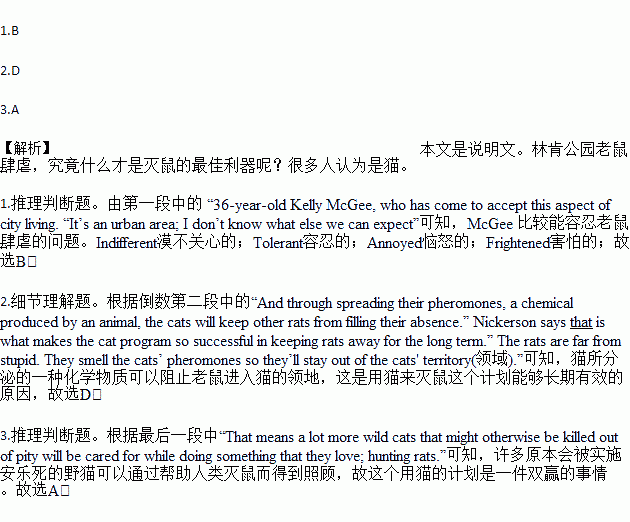题目内容
Like many thickly populated urban neighborhoods, Lincoln Park also has rats. A lot of rats. “Every night when I walk down the sidewalk, I see rats, ” says 36-year-oId Kelly McGee, who has come to accept this aspect of city living. “It’s an urban area; I don't know what else we can expect.”
McGee lives just down the block from the old Children's Memorial Hospital, which is about to be torn down as part of a massive redevelopment project. “Construction all over the city often disturbs rats that are living underground,” says Lincoln Park’s City Council representative, Alderman Michele Smith. “Every developer has to do active rat reduction on site, ”Smith says. Already, there are poisonous and inviting food boxes all around the old hospital complex. But the developer of the hospital site still warned residents in a recent community meeting that when digging begins later this month, the rat problem could be awful.
Victoria Thomas, who lives a few miles north of Lincoln Park in Chicago’s Lake View neighborhood, says she tried everything from underground fencing to poison traps to wipe out rats, but nothing worked until she got some cats. From the first day she got the cats, Thomas says the rats started to disappear.
“The cats will kill off a great deal of the initial population of the rats, ”says Paul Nickerson, who manages the Cats at Work program for Tree House Humane Society. “And through spreading their pheromones, a chemical produced by an animal, the cats will keep other rats from filling their absence.” Nickerson says that is what makes the cat program so successful in keeping rats away for the long term. ” The rats are far from stupid. They smell the cats’ pheromones so they’ll stay out of the cats’ territory(领域).”
After Smith highlighted the program in a recent newsletter, Nickerson and Tree House Humane Society have been getting lots of calls from people seeking their own cat colonies. That means a lot more wild cats that might otherwise be killed out of pity will be cared for while doing something that they love: hunting rats.
1.What is McGee’s attitude towards the rat problem?
A. Indifferent. B. Tolerant.
C. Annoyed. D. Frightened.
2.What does the underlined word in the last but one paragraph refer to?
A. Rats’ stupidity.
B. Tree House Humane Society.
C. Cat’s nature of killing rats.
D. The smell of cat’s pheromones.
3.What does the last paragraph suggest?
A. The program is a win-win thing.
B. Cats should be taken good care of.
C. Wild cats are more skilled at hunting.
D. It’s important to keep the ecological balance.
 三新快车金牌周周练系列答案
三新快车金牌周周练系列答案


 .
.